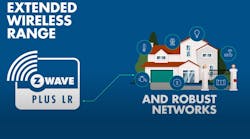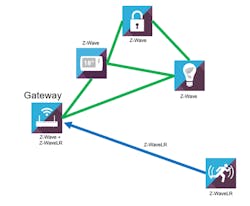What’s the Difference Between Z-Wave and Z-Wave Long Range?
What you’ll learn:
- The key technical benefits of the latest Z-Wave Long Range specification.
- How Z-Wave Long Range compares to Z-Wave.
In September 2020, the Z-Wave Alliance first announced the new Z-Wave Long Range (Z-Wave LR) specification and in December, announced that the new specification is now ready for third-party silicon certification program development. The first implementation of Z-Wave LR was also announced, now available from Silicon Labs, through a firmware upgrade to existing and new customers on the Z-Wave 700 platform.
This article breaks down the key technical benefits of Z-Wave LR and explores the differences between the latest specification and Z-Wave.
To start, what exactly is Z-Wave Long Range?
Engineered to provide significantly extended wireless range and support robust networks, Z-Wave LR extends Z-Wave connectivity beyond the boundaries of the home. It accelerates the adoption of Z-Wave in other verticals such as light commercial, hospitality, and multi-dwelling units (MDUs).
Z-Wave Long Range is an extra 100-kb/s DSSS OQPSK modulation addition to the Z-Wave protocol. The modulation is treated as a fourth channel, allowing gateways to add LR nodes to the existing Z-Wave channel scanning. At this time, Z-Wave LR is only available for the U.S. market. However, the Technical Workgroup is evaluating and testing to ensure compliance and be able to support Europe and APAC regions in the future.
Developed and managed by the new Z-Wave Alliance Technical and Certifications workgroups, the updated specification has been designed to usher in a new era of Z-Wave connectivity while still adhering to Z-Wave technology core values such as backwards compatibility and interoperability (see figure). The updated specification promotes a number of key technical benefits best summarized as “increased range and coverage, increased scalability, optimized battery life, and interoperability.”
Increased Range and Coverage
Perhaps the most exciting benefit of Z-Wave LR is the monumental increase in transmission range. The specification supports a maximum output power of 30 dBm, which can be leveraged to bolster range capabilities and support future transmission distance up to several miles. In the very first implementation of Z-Wave LR—from Silicon Labs through the 700 Series platform—a proven transmission distance of 1-mile (1.6 km) direct line of sight has been achieved utilizing +14-dBm output power.
Prior to Z-Wave LR, multiple signal repeaters would need to be installed within a network to achieve transmission distance beyond the boundaries of the home. Z-Wave LR eliminates the need for these repeaters, unlocking new potential for Z-Wave networks and making it easier than ever before to enroll smart home and IoT devices deployed at the edge of the network.
Increased Scalability
Along with a dramatic boost in transmission range, Z-Wave LR also increases scalability on a single smart-home network up to 4,000 nodes. Compared to Z-Wave (232 nodes), this represents a 20X increase in network node availability. Larger network support enables the addition of potentially thousands of Z-Wave devices on a single network, further expanding what’s possible with Z-Wave technology.
Optimized Battery Life and Backwards Compatibility
Z-Wave LR offers up to 10-year battery life on a single coin-cell battery by leveraging dynamic power control. This new feature enables the Z-Wave Long Range device to automatically adjust and optimize the radio output power at every transmission.
Dynamic power control is critical to supporting future-proof Z-Wave device installations. One of the most compelling use cases for sensors with increased battery life is the ability to deploy them in hard-to-reach places, such as attics, basements, or behind walls, to support evolving applications such as context aware and AI for IoT technology.
Z-Wave and Z-Wave LR also are designed to coexist on the same network. LR network nodes reserved for new or existing Z-Wave mesh-network devices preserve both backwards and forwards compatibility and sustain interoperability between certified Z-Wave devices.
Additional Differences: Z-Wave vs. Z-Wave Long Range
While the key technical benefits of Z-Wave LR are quite clear, a number of technical differences exist between the two specifications that are equally important to highlight. Most notable is Z-Wave LR’s use of a star network topology vs. the traditional mesh topology found within Z-Wave networks today.
Star Network vs. Mesh Network
Z-Wave LR devices operate on a star network topology that features the gateway/hub at a central point and then establishes a direct connection to devices. The addressing space in Z-Wave Long Range is increased to 12 bits, enabling Z-Wave LR networks to support up to 4000 nodes.
The key difference between a star network and a mesh network is the direct gateway/hub-to-device connection. Mesh networks traditionally permit signals to hop from node to node until the intended destination is met.
While the network topologies are different, Z-Wave is able to support both a mesh network and a star network. Both Z-Wave LR and traditional Z-Wave nodes can coexist within the same network, allowing for a wide variety and combination of Z-Wave devices and Z-Wave LR devices.
To unlock the full potential of Z-Wave LR, both the gateway/hub and the installed Z-Wave device must feature Z-Wave LR. So long as both the gateway/hub and connected device feature the Z-Wave LR specification, that network has the capability to support both a mesh network and star network.
Additional technical differences between the two specifications are spelled out in the table.
Since the announcement in September 2020 introducing the updated specification, the Z-Wave Alliance’s Technical Workgroup have been hard at work testing and deploying Z-Wave LR networks. It’s subsequently led to the discovery of additional advances, benchmarks, and benefits.
Under the new organizational framework of the Z-Wave Alliance and with the Z-Wave LR specification now available from Silicon Labs on its Z-Wave 700 platform, the future of Z-Wave technology looks very promising.
To keep up with Z-Wave, visit http://www.z-wavealliance.org.


